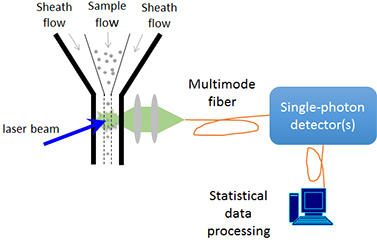Summary
Faint light detection is a staple in biology- used from systems biology research to bioassays for biomanufacturing and healthcare diagnostics.
Description

Applying recent advances in single-photon detection along with novel data processing methods developed in the quantum optics community opens fundamentally new opportunities for faint-light metrology down to that related to just a single molecule – i.e. precisely the conditions for bio-optical phenomena observations. The 2014 Chemistry Nobel Prize attests to the importance of single biomolecule optical measurements. Moreover, low-light-level-based systems account for a large and dynamic industry. Particularly, commercial planar array and flow cytometry (cell sorting) assays amount to >$10B annual market (and growing). Current detection metrology cannot adequately meet the increasing high sensitivity needs. Notably, calibration relies on standard materials with limited properties such as fixed emission wavelength, with unpredictable response to observation conditions, incongruous with the low analyte concentrations and no independent verification for the calibration. Advanced photon statistical methods promise such independent verifications with broader applicability.
Quantum biophotonics is an emergent field, where we learn how to apply the methods developed for quantum state characterization and manipulation to make sensitive, reliable and traceable measurements in an ever-changing bio-environment. Currently, we are developing a next generation discriminative measurement system for flow cytometers, in partnership with Lili Wang, MML. In a separate project we developed the smallest, very sensitive detector to be used for in-vivo detection of bioluminescence.
Major Accomplishments
- Pending US Patent Application No. 16/413078 for QUANTUM FLOW CYTOMETER, published as US Patent Application Publication No. 2019/0353578.
- Javier Sabines Chesterking, I.A. Burenkov, and S.V. Polyakov, “Single-emitter-sensitivity in flow cytometry verified by quantum measurement”, CLEO 2020, San Jose, CA 2020
- Ivan A. Burenkov, Yu-Hsiang Cheng, Sergey Polyakov, “Towards Quantum-Enabled Flow Cytometry”, CLEO 2018, San Jose, CA 2018

